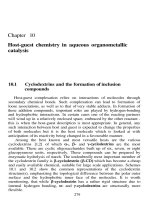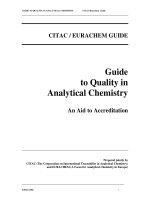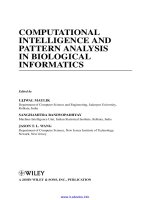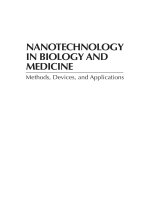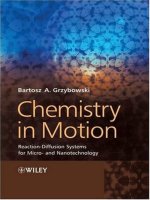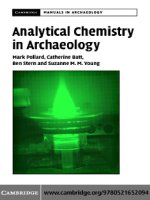pp chemistry in biology
Bạn đang xem bản rút gọn của tài liệu. Xem và tải ngay bản đầy đủ của tài liệu tại đây (1007.29 KB, 32 trang )
Chemistry in Biology
Chapter 6 Chemistry in Biology
6.1 Atoms, Elements, and Compounds
Atoms
Chemistry is the study of matter.
Atoms are the building blocks of matter.
Neutrons and protons are located at the
center of the atom.
Protons are positively charged particles.
Neutrons are particles that have no
charge.
Chapter 6 Chemistry in Biology
6.1 Atoms, Elements, and Compounds
Electrons are negatively charged particles
that are located outside the nucleus.
Chapter 6 Chemistry in Biology
6.1 Atoms, Elements, and Compounds
Elements
An element is a pure substance that cannot
be broken down into other substances by
physical or chemical means.
There are over 100 known elements, 92 of
which occur naturally.
Each element has a unique name and
symbol.
Chapter 6 Chemistry in Biology
6.1 Atoms, Elements, and Compounds
The Periodic Table of Elements
Horizontal rows are called periods.
Vertical columns are called groups.
Chapter 6 Chemistry in Biology
6.1 Atoms, Elements, and Compounds
Compounds
A pure substance formed when two or more
different elements combine
Compounds are always formed from a
specific combination of elements in a fixed
ratio.
Compounds cannot be broken down into
simpler compounds or elements by physical
means.
Chapter 6 Chemistry in Biology
6.1 Atoms, Elements, and Compounds
Chemical Bonds
Covalent bonds
Chemical bond that
forms when
electrons are
shared
A molecule is a
compound in which the atoms are held
together by covalent bonds.
Chapter 6 Chemistry in Biology
6.1 Atoms, Elements, and Compounds
Ionic Bonds
Electrical attraction between two oppositely
charged atoms or groups of atoms
Chapter 6 Chemistry in Biology
6.1 Atoms, Elements, and Compounds
van der Waals Forces
When molecules come close together, the
attractive forces between slightly positive
and negative regions pull on the molecules
and hold them together.
The strength of the attraction depends on
the size of the molecule, its shape, and its
ability to attract electrons.
Hydrogen “Bonds”
• The most important Van der Waals force is
Hydrogen Bonding. Hydrogen bonding is
not a “real” bond because it occurs
between compounds, and not within them.
• Hydrogen bonding requires Hydrogen (H),
and at least one of the following: Nitrogen
(N), or Oxygen (O), or Fluorine (F).
Chapter 6 Chemistry in Biology
6.2 Chemical Reactions
Reactants and Products
A chemical reaction is the
process by which atoms or
groups of atoms in
substances are reorganized
into different substances.
Clues that a chemical
reaction has taken place
include the production of
heat or light, and formation
of a gas, liquid, or solid.
Chemical reaction
Physical reaction
Chapter 6 Chemistry in Biology
6.2 Chemical Reactions
Chemical Equations
Chemical formulas describe the substances in
the reaction and arrows indicate the process of
change.
Reactants are the starting substances, on the
left side of the arrow.
Products are the substances formed during the
reaction, on the right side of the arrow.
Chapter 6 Chemistry in Biology
6.2 Chemical Reactions
Glucose and oxygen react to form carbon
dioxide and water.
Chapter 6 Chemistry in Biology
6.2 Chemical Reactions
Balanced Equations
The law of conservation of mass states matter
cannot be created or destroyed.
The number of atoms of each element on the
reactant side must equal the number of
atoms of the same element on the product
side.
Chapter 6 Chemistry in Biology
6.2 Chemical Reactions
Energy of Reactions
The activation
energy is the
minimum amount of
energy needed for
reactants to form
products in a
chemical reaction.
Chapter 6 Chemistry in Biology
6.2 Chemical Reactions
This reaction is
exothermic and
released heat energy.
The energy of the
product is lower than
the energy of the
reactants.
Chapter 6 Chemistry in Biology
6.2 Chemical Reactions
This reaction is
endothermic and
absorbed heat
energy.
The energy of the
products is higher
than the energy of
the reactants.
Chapter 6 Chemistry in Biology
6.2 Chemical Reactions
Enzymes
A catalyst is a
substance that lowers
the activation energy
needed to start a
chemical reaction.
It does not increase how
much product is made and it does not get
used
in
the
reaction.
up
Enzymes are biological catalysts.
Chapter 6 Chemistry in Biology
6.2 Chemical Reactions
The reactants that bind to the enzyme are called
substrates.
The specific location where a substrate binds on an
enzyme is called the active site.
Chapter 6 Chemistry in Biology
6.2 Chemical Reactions
The active site changes shape and forms
the enzyme-substrate complex, which helps
chemical bonds in the reactants to be
broken and new bonds to form.
Factors such as pH, temperature, and other
substances affect enzyme activity.
Chapter 6 Chemistry in Biology
6.3 Water and Solutions
Water’s Polarity
Molecules that have an unequal distribution
of charges are called polar molecules.
Polarity is the property of having two
opposite poles.
A hydrogen bond is a weak interaction
involving a hydrogen atom and a fluorine,
oxygen, or nitrogen atom.
Chapter 6 Chemistry in Biology
6.3 Water and Solutions
Visualizing
Properties
of Water
EnzymeControlled
Reactions
Chapter 6 Chemistry in Biology
6.3 Water and Solutions
Homogenous Mixtures
A mixture that has a
uniform composition
throughout
A solvent is a substance in
which another substance is
dissolved.
A solute is the substance
that is dissolved in the
solvent.
Food coloring dissolved in
water forms a homogenous
mixture.
Chapter 6 Chemistry in Biology
6.3 Water and Solutions
Heterogeneous Mixtures
In a heterogeneous
mixture, the
components remain
distinct.
A salad is a heterogeneous mixture.
Chapter 6 Chemistry in Biology
6.3 Water and Solutions
Acids and Bases
Substances that release hydrogen ions (H+) when
dissolved in water are called acids.
Substances that release hydroxide ions (OH–)
when dissolved in water are called bases.
